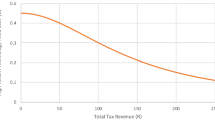Abstract
The idea of a poverty trap has been around for a long time, but remains relevant today. In the classic model, over time, a low-level attractor pulls in any wealth-poor people nearby. Yet, this coexists with other, preferred, equilibria—some stable, some not. Getting people out of the trap will not be possible with only a small transient gain in wealth, and people in their better equilibrium can be vulnerable to large downside shocks. The idea has important implications for development policy, including social protection.
Access provided by Autonomous University of Puebla. Download chapter PDF
Similar content being viewed by others
The idea of a poverty trap has been around for a long time but remains relevant today. In the classic model, over time, a low-level attractor pulls in any wealth-poor people nearby.
Yet, this coexists with other, preferred, equilibria—some stable, some not. Getting people out of the trap will not be possible with only a small transient gain in wealth, and people in their preferred equilibrium can be vulnerable to large downside shocks. The idea has important implications for development policy, including social protection.
The multiple equilibria can arise from the existence of threshold effects. The following are examples:
-
Physiology: The fact that basal metabolic rate is positive means that the human body at rest requires a minimum food-energy intake before any physical work can be done.
-
Lumpy “threshold goods”: My students know that they have little hope of an earnings bump from just 1 day of schooling! There is some critical minimum for human capital.
-
Punishment incentives do not bite when a person is close to the lowest possible utility. So a poor person may have a hard time convincing lenders (and others) that she is trustworthy. Thus, market failures can stem from poverty, as well as creating it.
-
Economies can get caught in a poor-institutions trap—a PIT. This arises when institutional development is impossible at certain low levels of state capacity.
In another class of membership models, the persistence of poverty emerges from external effects of group membership. Sociologists have emphasized how the lack of role models can limit the life chances of children growing up in poor neighborhoods. The network effects get built into expectations about future prospects, inhibiting progress out of poverty.
Geographic externalities in economic development can have similar implications. In these models, living in a poor area makes it less likely one will escape poverty in the future, because the poor local infrastructure lowers the productivity of personal investments. This is a causal effect of location on poverty, not simply a geographic concentration of people with similar characteristics.
Another form of poverty trap can emerge with weak law enforcement and weak state capacities generally, such that poverty and corruption reinforce each other in a vicious cycle. People face a choice between legal and illegal entrepreneurship. Under certain conditions, one can find a “predation trap,” a stable equilibrium in which predatory behavior is endemic and profits from productive enterprise are low.
Indeed, whole economies can be caught in a poverty trap. The combination of interdependence among households and/or firms with coordination failures has long been an argument for industrial policies and external development assistance. Coordination failures can also lead to recessions and even mass unemployment.
Once one thinks about it, poverty traps could well be pervasive. But they can also be hard to see. The signs of their presence could be just a relatively small number of destitute people. Or the trap may only be obvious in crises, such as famines, when institutions come under great stress. It is clearly hazardous to say from empirical observations at normal times that a trap does not exist. So please don’t forget about this idea.
Literature
Bowles, S., Durlauf, S., & Hoff, K. (Eds.). (2006). Poverty traps. Princeton: Princeton University Press.
Author information
Authors and Affiliations
Corresponding author
Editor information
Editors and Affiliations
Rights and permissions
Copyright information
© 2019 Springer Nature Switzerland AG
About this chapter
Cite this chapter
Ravallion, M. (2019). Martin Ravallion Recommends “Poverty Traps” by Samuel Bowles, Steven Durlauf, and Karla Hoff. In: Frey, B., Schaltegger, C. (eds) 21st Century Economics. Springer, Cham. https://doi.org/10.1007/978-3-030-17740-9_36
Download citation
DOI: https://doi.org/10.1007/978-3-030-17740-9_36
Published:
Publisher Name: Springer, Cham
Print ISBN: 978-3-030-17739-3
Online ISBN: 978-3-030-17740-9
eBook Packages: Economics and FinanceEconomics and Finance (R0)




